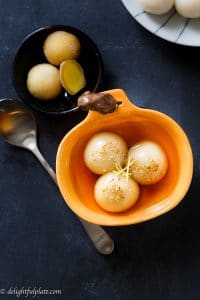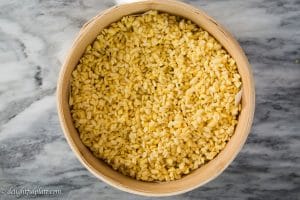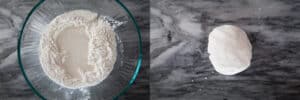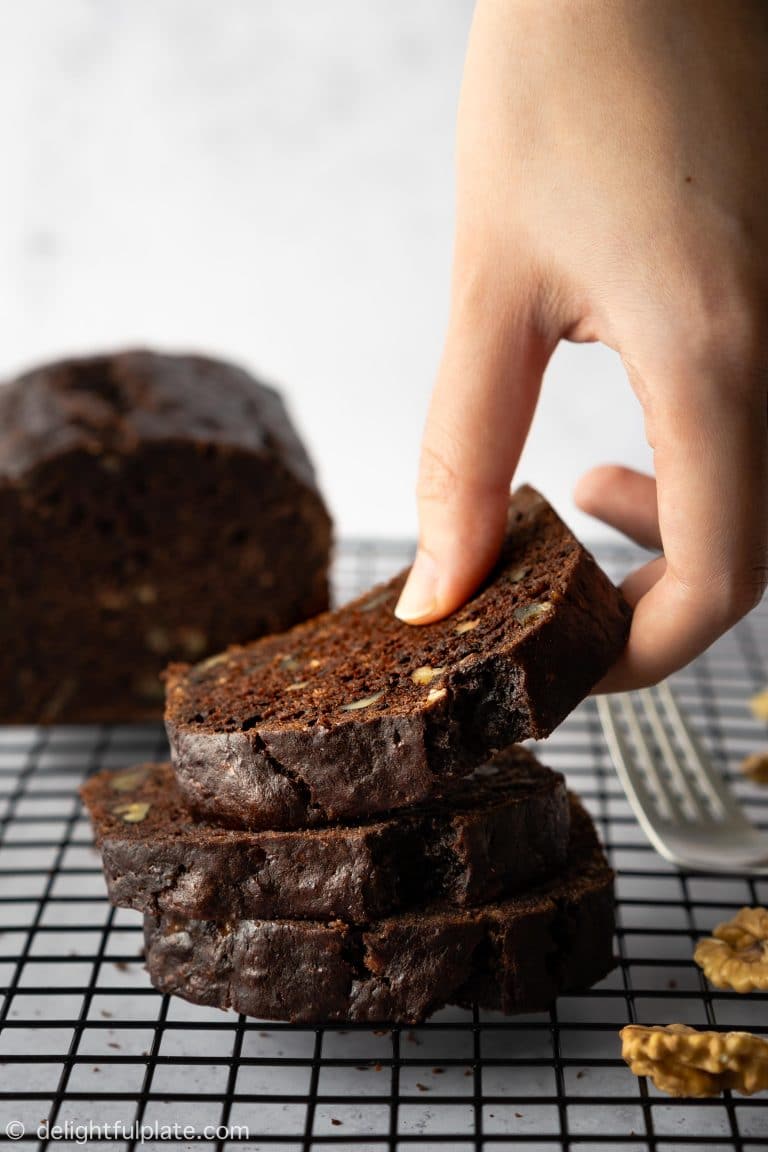Vietnamese Glutinous Rice Balls in Ginger Syrup (Che troi nuoc)
Vietnamese Glutinous Rice Balls (Che troi nuoc) are filled with mung bean paste and bathed in the fragrant and sweet ginger syrup. This warm dessert is very fulfilling and comforting.

Overview of Vietnamese Glutinous Rice Balls in Ginger Syrup (Che troi nuoc)
Growing up in Vietnam, I got to eat and love many warm desserts, like che chuoi (banana tapioca pudding) or this glutinous rice balls/dumplings in ginger syrup. In Vietnam, we call this dessert “che troi nuoc“.
The name is derived from the fact that the rice balls/dumplings will float to the surface when cooked through. It’s difficult to find an equivalent name in English, so you can call it glutinous dumplings, glutinous rice balls, sticky rice balls or whatever you like :).
The skin of the rice balls is glutinous rice flour and it has an addictive soft-chewy texture. The filling is creamy mung bean paste which is slightly sweet. The combination of the rice balls and the ginger syrup is pure heaven on cool fall days or cold winter days. We usually sprinkle sesame seeds or chopped peanuts over it to add a nutty flavor and increase the deliciousness of che troi nuoc.
Making Vietnamese Glutinous Rice Balls in Ginger Syrup (Che troi nuoc)
We will discuss in more details, but here are some important tips for making this delicious dessert:
1. Choose the glutinous rice flour (sweet rice flour, sticky rice flour) which is made from grinding glutinous rice with water.
2. Soak mung bean for a few hours will shorten the cooking time.
3. Gently and slowly wrap the dough tightly around the filling. Avoid letting air pockets between the dough and filling, because the air pockets can make the dumplings break when we cook them.
Ingredients
To make Vietnamese glutinous rice balls, you need glutinous rice flour, mung bean, shredded coconut (optional), coconut milk and regular sugar. Apparently, there are two types (at least as far as I know) of glutinous rice flour. The first type is made from grinding sticky rice finely with water. Vietnamese or Thai glutinous rice flour sold in Asian grocery store is this type, and it is the best for making these dumplings.
The second type is made from grinding just sticky rice, for example, Japanese mochiko flour belongs to this category. If you make these dumplings with this flour, the end product is not as soft as using the first type. Therefore, please check to make sure you purchase the right flour. The ingredient list of the flour should say glutinous rice and water only. For your reference, this is the glutinous rice flour brand I usually buy.
The ginger syrup requires fresh ginger and palm sugar. You can easily tell from its name that palm sugar is made from palm tree. It has a light caramel color, and its sweetness doesn’t feel as sharp as white sugar. Using palm sugar gives the syrup a beautiful golden color which is a little lighter than the color of honey. You can find palm sugar at Asian grocery stores.

How to Make Vietnamese Sweet Glutinous Rice Balls (Che troi nuoc)
The first step of making che troi nuoc is to make the filling. You need to cook the mung bean until it is very soft, and then mash or process finely in a food processor. After that, you mix it with sugar, coconut milk, and coconut to create the mung bean paste. Divide the paste and form into small balls.
After you have the filling ready, proceed to making the dough. First, mix glutinous rice flour with lukewarm water. Knead for a couple of minutes, then divide and form small dough balls. You need to gently wrap the dough tightly around the filling and try to avoid creating air pockets as much as you can. Instructions and step-by-step photos are in the recipe below. Next, bring a large pot of water to a boil and drop the balls to the pot. You know they are cooked when they float to the surface.
Making the ginger syrup is very easy. You just simmer ginger and palm sugar in a pot of water. You can add one or two knotted pandan leaves to the syrup for more fragrance but it is totally optional. When the syrup is ready, add the glutinous dumplings and simmer for about 5-7 minutes. This step will make the dumplings softer, and the skin will turn from white to a subtle golden hue.
Some people like to drizzle some coconut sauce when serving (usually in Southern Vietnam), but I don’t think it’s a must. You can make the coconut sauce by simmering coconut milk and adding some tapioca starch (or corn starch) slurry to thicken it to your liking.
I’d love to hear what you think about the dish, so please feel free to leave a comment. You can find my collection of Vietnamese recipes here. New recipes are added every week so let’s connect on Facebook, Pinterest and Instagram for the latest updates.

Vietnamese Glutinous Rice Balls in Ginger Syrup (Che troi nuoc)
Ingredients
For the filling
- 3.5 oz mung bean (about 100grams)
- 1/8 teaspoon salt
- 1 teaspoon olive oil (5ml)
- 1/3 cup coconut milk (80ml)
- 1 tablespoon granulated sugar (or more to taste)
- 1/3 cup shredded coconut (optional)
For the skin
- 7 oz glutinous rice flour (about 200grams)
- 1/8 teaspoon salt
- 5/6 cup lukewarm water (about 200ml)
For the ginger syrup
- 4 cups water (960ml)
- 1 2” long chubby piece of ginger (peeled and thinly sliced)
- 7 oz palm sugar (about 200grams, to taste)
- 1-2 knotted pandan leaves (optional)
Other ingredients
- toasted sesame seeds
Instructions
Making the filling
- If you have time, soak mung bean in water for 4-6 hours or overnight. You can skip soaking, but you will need to increase cooking time.
- Wash and drain mung bean. Add salt and mix well. Set up a steamer and steam for about 15 minutes or until mung bean is soft. If you don’t soak the mung bean in advance, steam for longer and add a couple teaspoons of water to the mung bean when steaming.
- Mash or process mung bean finely in a food processor. In a pan over medium low heat, add olive oil and transfer mung bean to the pan. Add sugar, coconut milk and shredded coconut. Mix well to combine into a mixture which you can squeeze and form balls easily.
- Use a little over 1/2 tablespoon of filling (tightly packed) to make a ball of filling. You can make about 25 balls. Set aside.
Making the skin
- In a mixing bowl, add glutinous rice flour and mix in salt. Add lukewarm water, mix to combine and knead for a couple of minutes into smooth dough. (If mixture is too wet, add a little more flour. If mixture is too heavy and dry, add a small amount of water.)
- Divide the dough into 25 equal pieces. Lightly dust your hands with flour. Roll each piece between your palms to form a small ball of dough. While you work through the dough, cover the portion that hasn’t been used with damp towel to prevent it from drying.
Assembling the rice balls
- Flatten the ball of dough with your hand into a round with 2” – 3” diameter. Place a ball of filling in the center, gently wrap the the dough tightly around the filling: use your fingers to stretch and wrap, then pinch the dough at the top to seal it. Roll the ball between your palms to smooth the outside and form round shape.
- Bring a large pot of water to a boil, then lower heat to medium – medium high. Add rice balls, when they float to the surface, cook for one more minute and then transfer to an ice bath.
Making the ginger syrup and putting everything together
- In a pot, add all ingredients to make the syrup. Bring to a boil then lower heat and simmer until sugar is dissolved and water has been infused with ginger scent.
- Remove rice balls from ice bath and add them to the pot of ginger syrup. Simmer for 5-7 minutes.
- Transfer rice balls to serving bowls, sprinkle sesame seeds, ladle ginger syrup into each bowl and serve hot.
Notes
- Choose the glutinous rice flour which is made from grinding glutinous rice with water.
- Gently and slowly wrap the dough tightly around the filling. Avoid letting air pockets between the dough and filling, because the air can make the dumplings break when we cook them.
















Hello, how long could the ginger sugar syrup store if I want to pre-make the syrup and freeze the uncooked glutinous rice balls, and just heat up/cook a few at a time?
Thank you.
How many are in one serving (for the nutritional breakdown). Thanks
Hi, I just tried to make your recipe (without the mung bean filling) but the balls are refusing to cook. I boiled them for over an hour and they are still hard, never rising to the surface. I used to eat these all the time in Vietnam and I’m so disappointed that it’s not working 🙁
Is there a trick of some kind to help them cook?
Hi Ambrym,
I’m sorry to hear that. I just made a small batch of the dough again to retest it. I made small balls (about 12g each) without filling and they were cooked after 4-5 minutes of boiling. After about 3-3.5 minutes, they started to rise and subsequently floated on the surface.
Could you let me know the brand of glutinous rice flour you used? There are many brands of glutinous rice flour on the market and not all of them are the same. I recommend using Vietnamese or Thai glutinous rice flour which is very fine and light. Also, glutinous rice flour isn’t the same as rice flour.
Hi Sophie!
Thanks for taking the trouble to try again. I think I figured out the problem: I had rice flour, not glutinous rice flour. I hadn’t realised it was the wrong one… I’ll try again with the right flour and let you know how it goes!
Hi Sophie, I m very excited to try this recipe. What type of Mung beans do you use? Is it the peeled ones or the regular green beans?
Hi Ylan,
I use the peeled split mung beans (yellow ones with no skin). I’m sorry for not making it clear in the recipe :).
How long will they stay fresh and how do I store them after they are made?
Are they room temperature safe?
Hi Shiny,
After making them, you can store them in the refrigerator for a couple of days. Longer than that, the skin can get too soft and soggy. When you want to eat them, you can add some dumplings and ginger syrup to a bowl and reheat in the microwave. I wouldn’t leave them out at room temperature for too long, and they are best served warm or hot.
Dear Sophie,
I am an English teacher in a resort. As I was preparing a lesson plan on “how to teach the glutinous rice dumpling in ginger syrup making class” for my pastry students, I stumbled upon your recipe and found it very helpful. The lack of academic vocabulary in the field have always challenged me enormously, so thank you for helping me in a way that I think you have just been aware of. Please keep up your work because I’m going to introduce this site to my students and I believe it will be of numerous benefits to them. 🙂
Hi Mimi!
Thank you for your kind words! I’m so happy that you found my post helpful. I admit that I have never thought my recipe would be useful in such a way :). May I ask which resort you are teaching at? Please don’t feel pressured to answer my question though. I’m sure people who are going to attend the glutinous rice dumpling cooking class at the resort will find it very interesting.
Thanks again!
Sophie
thanks for information of this Vietnamese dessert!! I eat it in Vietnam ed I love it!
Hi Elisa! It’s great that you tried it in Vietnam and loved it :). Please feel free to let me know how it goes if you decide to make it at home. Thanks!